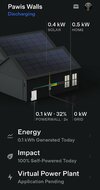I have a 7kw system on SCE but from NRG using SolarEdge inverters. Almost $0 dollar bills. Sometimes it's $6 up to $20. I have a MYLR.
I am interested in a Powerwall, maybe 1 or 2, unsure.
Will I be able to monitor real time usage on the Tesla app? Also, who's a good retailer in the So Cal area?
I am interested in a Powerwall, maybe 1 or 2, unsure.
Will I be able to monitor real time usage on the Tesla app? Also, who's a good retailer in the So Cal area?



